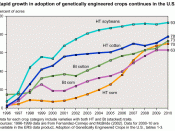Recently, genetically engineered foods have taken center stage on a debate over their health effects. Even though biotechnology has been around for many years, the long term effects of the "new" genetically engineered foods is unknown. This is because the new biotechnology doesn't use traditional plant breeding, but actually splices the plants at the genetic level. This type of genetic engineering is relatively new, and the health effects of these new foods are more complex than it may seem.
One of the health effects of genetically engineered foods is that when someone eats it, they don't know exactly what they are eating. This is because if a gene from a food that commonly causes allergic reactions, like fish or peanuts, is inserted into tomatoes or corn, where people would not expect to find these allergens, and then it could cause a potentially fatal reaction. The easy remedy for this could be to just label all foods with known allergens in them, but what that actually means is up for debate.
Some say that no labeling should be required unless it is proven that the genes from allergens actually affect the foods they are spliced with, while others say that regardless, all foods with any kind of an allergen in them should be labeled. The FDA's stance on this is that unless a company can scientifically demonstrate that the allergenic component was not transferred to the food, then it must be labeled to alert sensitive consumers. While allergens pose many serious health risks, there are many other factors that contribute to the GE foods debate.
A problem that commonly arises with GE foods is that the nutritional content of a food is changed. For example, tomatoes are a major source of vitamin C. Now it could be that someone comes up with a new tomato that is much hardier and is therefore not damaged so easily. The downside of this could be that the new tomato will not be as rich in vitamin C as it was before. If the tomato is changed and does not lose it's nutritional value, then it doesn't have to be disclosed though. The tomato would have to be labeled though if the engineering changes the composition of the tomato in such a way that it's really not the same tomato anymore. Aside from this, the testing a company does before the food is considered safe for the public must also be taken into account.
As far as what is done before the food is offered to the public to ensure it is safe, there are many things that look quite promising. In May, the FDA published a notice in the Federal Register providing a guide for companies that establishes a standard of care. What's happening now is that companies are going to the FDA and telling them what kinds of tests they're proposing based on the guidance in the notice, and then asking for the FDA's advice. In this aspect, GE foods are looking very good, but there is one more aspect that must be taken into account.
The final health risk of GE foods is the fact that when you engineer something genetically, it can have other effects that are much farther-reaching than it would seem. An example of this would be genetically engineering apples with BT, the chemical used to kill insects. Sure, this would work in the short-term, but after time, the insects might develop resistance to BT. In turn causing the farmers to lose a very effective and very non-toxic tool. It is long-term effects such as this that make GE foods risky, and many people who are certified professionals in the biotechnology field say that it needs to be looked at more closely.
In the end, it doesn't even matter, because GE foods will be making their way onto store shelves sooner than we know it, and if the FDA says they are safe, there is little anyone can do to stop it. The only thing the average American can do is educate themselves on the issue and avoid GE foods if they feel they are not safe.





